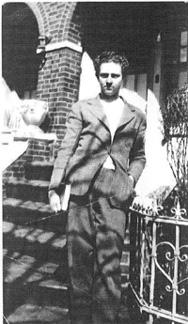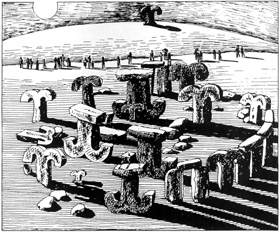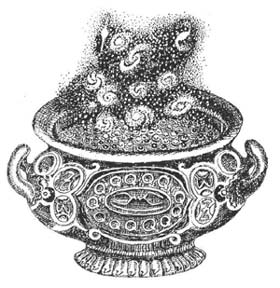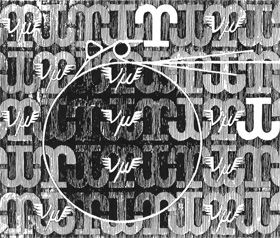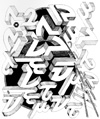"Golden Books" - An Eclectic Reader on Leon M. Lederman
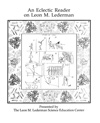 |
An Eclectic Reader on Leon M. Lederman
|
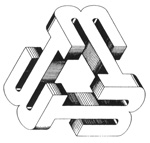 |
 |
![]()
Fermi National Accelerator Laboratory
Batavia, Illinois
Operated by Universities Research Association, Inc.
Under Contract with the United States Department of Energy
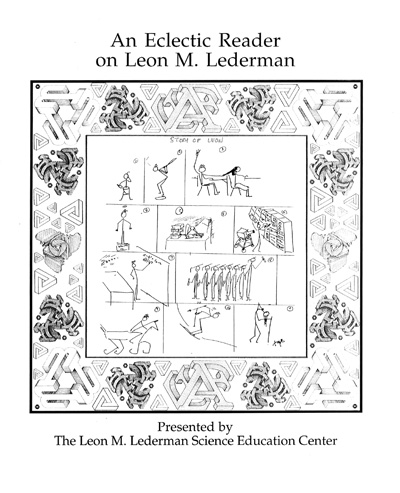
The Cover
Drawn and written by Leon with added decorative border (depicting Mobius version of the symbol νµ, Friends of Fermilab Association (FFLA), and Prospice Adspice and Respice in the form of a human head facing in the direction of past, present and future.
"I distinctly recall my awesome skill at learning the physics that children, age 0 to 6 years, need to negotiate in the complex world, e.g. to walk upright and get milk out of a bottle. Fortunately, the necessary chemistry and biology came naturally. Applying the skill later to "little league" and other related institutions designed to torture pre-teenagers was much less successful. It was more fun to dip Alice's blonde hair in the inkwell provided on all our school desks. How else to show undying love? My school work was exemplary but required long hours of study until very late at night. This led to laboratory research. The oscilloscope was my essential companion as we designed electronics for our experiments. Then there was the teaching and the pride of a growing number of graduating students. Finally the time came to relax, ride horses, ski and grow old gracefully."

Leon M. Lederman Fermilab, 1995
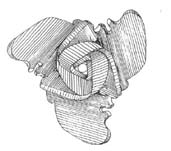
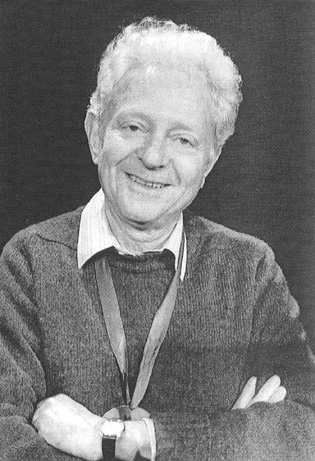
 Leon relaxing with family pet, Chloe, in Idaho, 1994 |
|
 Leon at his Bar Mitzvah, 1935 |
A concise story of Leon appears on the cover. Many significant as well as very serious aspects of his life may be seen in a glance. Below is a list of additional facts.
His Career
| July 15, 1922 | Leon Max Lederman born in New York City |
| 1927 | Attended PS 92 on Broadway and 95th Street, New York |
| July 15, 1935 | Bar Mitzvah |
| June, 1939 | Graduation from James Monroe High School, New York |
| 1943 | Graduation from City College of New York, B.S. in Chemistry |
| 1943-1946 | U.S. Army Signal Corps, stationed in France |
| 1948 | M.S. in Physics, Columbia University |
| 1951 | Ph.D. in Physics, Columbia University |
| 1951-1989 | Faculty, Columbia University |
| 1953-1961 | Associate Director, Nevis Laboratories, Irvington, New York |
| 1961-1979 | Director, Nevis Laboratories, Irvington, New York |
| 1972 | Eugene Higgins Professor, Columbia University |
| 1979-1989 | Director, Fermi National Accelerator Laboratory |
| 1983 | Founder, Friends of Fermilab Association |
| 1985 | Founder, Illinois Mathematics and Science Academy |
| 1989-1992 | Frank E. Sulzberger Professor, University of Chicago |
| 1989-1992 | Science Advisor to Governor of Illinois |
| 1990 | Founder, Teachers Academy of Mathematics and Science in Chicago |
| 1990-1993 | President-Elect, President and Chairman of the Board, American Association for the Advancement of Science |
| 1992-present | Pritzker Professor of Science, Illinois Institute of Technology, Chicago |
| 1998-2012 | Resident Scholar, Great Minds Program, Illinois Mathematics and Science Academy |
Observation in Particle Physics from Two Neutrinos to the Standard Model.*
Experimentalists are often specialists in reactions initiated by particular particles. I have heard it said that there are some physicists, well along in years, who only observe electron collisions. In reviewing my own bibliography, I can recognize distinct periods, not too different from artists' phases, e.g., Picasso's Blue Period. My earliest work was with pions, which exploded into the world of physics (in 1947) at about the time I made my quiet entry. Later I turned to muons mostly to study their properties and to address questions of their curious similarity to electrons, e.g., in order to answer Richard Feynman's question, "Why does the muon weigh?" or Rabi's parallel reaction, "Who ordered that?" Muons in the intense beams from the AGS turned out to be a powerful probe of subnuclear happenings not only in rather classical scattering experiments (one muons in, two muons out). A brief sojourn with neutral kaons preceded the neutrino program, which my colleagues will have discussed in detail. This led finally to studies of collisions with protons of the highest energy possible, in which leptons are produced. This last phase began in 1968 and was still going on in the 1980's.
Accelerators and detection instruments are essentials in particle research but there also needs to be some kind of guiding philosophy. My own approach was formed by a specific experience as a graduate student.
My theses research at Columbia University involved the construction of a Wilson cloud chamber designed to be used with the brand new 400-MeV synchrocyclotron under construction at the Nevis Laboratory about 20 miles north of the Columbia campus in New York City.
I. I. Rabi was the Physics Department Chairman, maestro, teacher of us all. He was intensely interested in the new physics that the highestenergy accelerator in the world was producing. At one point I described some curious events observed in the chamber which excited Rabi very much. Realizing that the data were very unconvincing, I tried to explain that we were a long way from a definitive measurement. Rabi's comment, "First comes the observation, then comes the measurement," served to clarify for me the fairly sharp distinction between "observation" and "measurement." Both experimental approaches are necessary to progress in physics. Observations are experiments which open new fields. Measurements are subsequently needed to advance these. Observations may be qualitative and may require an apparatus that sacrifices detail. Measurement is more usually concerned with the full panoply of relevant instruments. And of course, there are blurred boundaries. In the course of the next 30 or so years I have been concerned with measurements of great precision, e.g., the magnetic moment of the muon (Coffin et al., 1957), or the mass, charge, and lifetime of the muon (Devons et al., 1960), measurements of moderate precision like the rho value in muon decay, the elastic scattering of muons (Ellsworth et al., 1968), or the lifetimes of the lambda and kaon particles (Blumenfeld, Chinowsky, and Lederman, 1958). I have also been involved in observations, which are attempts to see entirely new phenomena. These "observations" have, since 1956, been so labeled in the titles of papers, some of which are listed in chronological order in Table I and as references (Laude et al., 1956; Garwin et., 1957; Danby et al., 1962; Christenson et al., 1970; Busser et al., 1973; Herb et al., 1977; Finocchiaro et al., 1980). I selected these because (1) I loved each one and (2) they were reasonably important in the evolution of particle physics in the amazing period from the 1950's to the 1980's.
*An excerpt front the December 8, 1988 lecture given on the presentation to Lederrnnan of the Nobel Prize for Physics and published in Rev. Mod. Phys. 61:3, July 1989, pp. 547-560.
Leon's Graduate Students 1951-1979
 Skiing is often a favorite pastime of a physicist. It is a "return" to "classical (basic) physics".
Skiing is often a favorite pastime of a physicist. It is a "return" to "classical (basic) physics".
Newton's law of gravitation. Any two masses attract each other with a force directly proportional to the product of their masses, and inversely proportional to the distance separating their centers of mass.
Newton's laws of motion. 1. Any body at rest or moving with a uniform translational motion will maintain this condition unless acted upon by an external force. 2. The time rate of change of momentum is equal to the force applied.
![]()
where F = force, m = mass, p = momentum, v = velocity, and a = acceleration. 3. For every force there is an equal and opposite force. (That is, in any system where A exerts a force on B, B is at the same time exerting an equal force on A.)
Vacations are often a disruption of the pleasure of work. The new fax machine sent to the vacation spot not only brings "up to date" but also connects with the experiment and the "outside world".
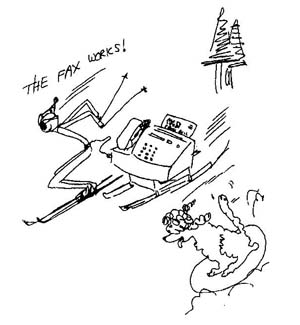
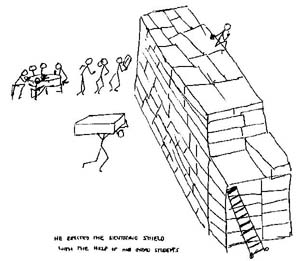 Shielding may be an armor to ward off an attack. In high-energy physics experiments shielding may protect man and equipment from unwanted radiation, or it may, as in the "neutrino shield", stop every unwanted particle except the neutrino to make a neutrino beam (a filter). "Grad students" (aspiring Ph.D.'s) are among the pride of an experimenter. They are both an inspiration and of great help with hard work that requires youth, wit, strength and intelligence.
Shielding may be an armor to ward off an attack. In high-energy physics experiments shielding may protect man and equipment from unwanted radiation, or it may, as in the "neutrino shield", stop every unwanted particle except the neutrino to make a neutrino beam (a filter). "Grad students" (aspiring Ph.D.'s) are among the pride of an experimenter. They are both an inspiration and of great help with hard work that requires youth, wit, strength and intelligence.
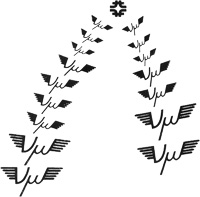 A swarm of winged rnuon neutrinos (Leon's Nobel discovery) first published in 1962 pursued by the archer, stone thrower, and a sensitive cannon operator.
A swarm of winged rnuon neutrinos (Leon's Nobel discovery) first published in 1962 pursued by the archer, stone thrower, and a sensitive cannon operator.
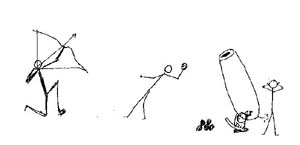 Throwing stones, shooting arrows and cannon balls are the earliest manifestations of how motion is controlled by force. This was soon extended to the motion of planets and stars and the grand success encouraged a belief that everything in nature was knowable-even the smallest bits of matter that compose the world. Magnifying glasses, microscopes of ever-increasing power bring us down to the ultra small-at each level, new and marvelous insights! The newer "microscopes" are devices of monstrous size but exquisite precisionaccelerators-they enable us to "see" such exotic bits as the muon neutrino-particles that soar freely as birds through the densest of matter and, remote, abstract as they are, they determine the world as it is-the beam of sunlight through a heavy sky that illuminates a pond.
Throwing stones, shooting arrows and cannon balls are the earliest manifestations of how motion is controlled by force. This was soon extended to the motion of planets and stars and the grand success encouraged a belief that everything in nature was knowable-even the smallest bits of matter that compose the world. Magnifying glasses, microscopes of ever-increasing power bring us down to the ultra small-at each level, new and marvelous insights! The newer "microscopes" are devices of monstrous size but exquisite precisionaccelerators-they enable us to "see" such exotic bits as the muon neutrino-particles that soar freely as birds through the densest of matter and, remote, abstract as they are, they determine the world as it is-the beam of sunlight through a heavy sky that illuminates a pond.

Leon credits his brother, Paul, as perhaps the major influence on his early education. "(Paul) was always tinkering with things at home ... and he imparted a lifelong fascination for the kind of mechanical relationships that are part of science. Paul never even finished high school, but I count him as one of my best teachers." Discover, October, 1981.
"I got an excellent free education in New York's public schoolsthey were good then {1928-1939}. Then I got a free college education at CCNY. I went to graduate school under the GI Bill. Then when I got my degree, I was handed the finest equipment to do the work I most wanted to do. And now they are giving me a medal (1965 National Medal of Science). That's really pretty funny." New York Post, October 2, 1966.
"The best discoveries always seem to be made in the small hours of the morning, when most people are asleep, where there are no disturbances and the mind becomes most contemplative. You're out in a lonely spot somewhere, looking at the numbers on reams of paper spewing out of a computer. You look and look, and suddenly you see some numbers that aren't like the rest-a spike in the data. You apply some statistical tests and look for errors but no matter what you do, the spike's still there. It's real. You've found something. There's just no feeling like it in the world." Discover, October, 1981.
"Scientific literacy in this country is really a terrible problem. We're just not getting the bright kids going into science in school, and our graduate science programs have very few Americans ... If parents are uncomfortable with science, then their children are going to be uncomfortable, too." Chicago Tribune, October 20, 1988.
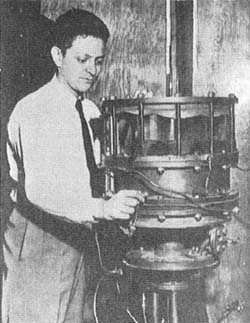 Cloud Chamber 1950 NEVIS Cyclotron Lab |
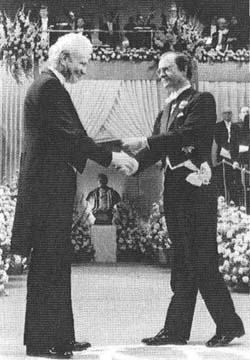 Leon receiving Nobel Prize from King Carl XVI Gustaf of Sweden |
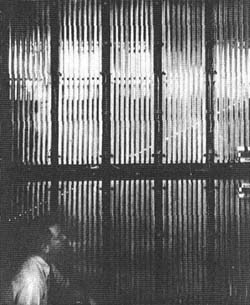 Leon and his first neutrino detector |
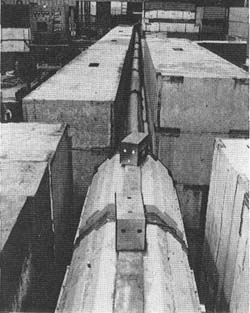 Shielding for 1977 Fermilab E-288 |
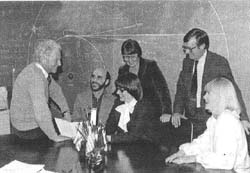 Left to right, Leon Lederman, James Reubush, Marge Bardeen, Stanka Jovanovic, Robert Riley and Judy Schramm, who created Friends of Fermilab. Now 16 years old, the enthusiasm and generosity of its members triggered the success of the precollege education programs at Fermilab |
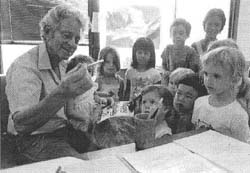 Children visit with Leon on his 60th birthday, July, 1982 |
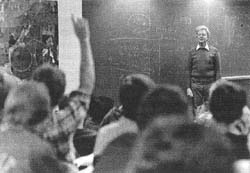 Leon Lederman responding to an attentive pupil in Saturday Morning Physics |
| 1956 | Discovery of Neutral K-Meson |
| 1957 | Discovery of Parity Violation in Pion and Muon Decay |
| 1961-1962 | Two-Neutrino Experiment |
| 1965 | Discovery of Antideuteron Election to the National Academy of Sciences |
| 1965 | U.S. National Medal of Science |
| 1969 | Discovery of Drell-Yan Process |
| 1976 | Elliot Cresson Prize of the Franklin Institute |
| 1977 | Discovery of Upsilon, bottom quark |
| 1982 | Wolf Foundation Prize in Physics (Israel) |
| 1988 | Nobel Prize in Physics |
| 1992 | Enrico Fermi Prize of the US Department of Energy |
| 2012 | Vannevar Bush Prize |

The Leon M. Lederman Science Education Center A Catalyst for the Desire to Know
There are many reasons why knowledge and the pursuit of knowledge are pleasurable and profitable. The pleasure of discovery is shared between the arts, the sciences, explorers of exotic places or, sometimes, simply in the varied human reactions to beauty, and wonder. Scientific discoveries are occasionally accidental, like radioactivity, or the microwave radiation that fills the universe. More often, it is the result of inspiration, hunch and the hard work to examine the consequences; or, as in the story of the electron, a relentless determination to understand some phenomenon. Early on it was the regular alterations of night and day and the notion of the stars and planets. With the marriage, in the 16th century, of mathematics and experimentation, scientific knowledge exploded.
In our story, which took place a hundred years ago, a curious and determined English scientist, J. J. Thomson, discovered the electron. He was working on an old problem, started by Michael Faraday in the 1830's who noticed that if one pumped most of the air out of a glass tube and sealed metal plates into two ends of the tube, that the application of high voltages across the tube resulted in a beautiful display of colored radiation streaming between the plates. Faraday named these "cathode rays" and predicted their explanation would have great significance for our knowledge of matter. In 1897, Thomson had established that cathode rays were actually streams of electrically charged particles. When Leon Lederman's team at Fermilab discovered the Upsilon particle eighty years later, "beauty quarks" had already been named. It was the same for Thomson -- his discovery had already been named "electron" by scientists who suspected that electrical charge was carried in discrete and constant units by corpuscles.
The electron opened the gate to essentially all of 20th century science and of the spectacular technology that followed: the physicist's atoms, the chemist's molecules, the structure of the molecular biology, the knowledge of materials, insulators, conductors, semi-conductors . . . then transistors and lasers and a Pandora's box of instruments which, in turn further advanced our knowledge. Quite an achievement John Julius Thomson! But there are other roads to knowledge ...
A pot filled with water, placed on a fire, is a grand experiment performed everyday in millions of kitchens throughout the world. As the water gets hotter, the molecules move faster and the spaces between them become greater. When the water becomes steam, it needs to occupy more space than when it was a liquid. If the lid on the pot is loosely fastened, it will bob up and down to let some of the steam escape as it forms. If the pot is sealed, it may burst!
When a 12 year old boy named James Watt (1736-1819) visited his mother in her kitchen, he observed steam escaping from a pot of boiling water, lifting the lid, and almost throwing it off the pot. Watt's curiosity was intense enough to inspire him to search for the secret to this phenomenon. His acquired knowledge led to the invention of the steam engine. Visiting the kitchen can be an introduction to physics, chemistry and other sciences.
James Watt's visit changed the face of the earth. The steam engine drove the rail cars across continents faster than any kind of transportation before steam. It also ended fashioning objects by hand. Objects that could be machine made such as woven cloth, nails, wire, spoons, shoes, almost all things that a "machine made" now were first "machine made" with Watt's steam engine.
Another form of discovery is associated with construction of a theoretical model, a model based on the knowledge of previous discoveries. The building blocks of a model are often mathematical calculations that provide the experimenter with clues of how to construct an experiment and what to look for. A discovery like that is the proof of a theoretical model. The variations on this theme are endless. Sometimes a routine measurement leads to a surprising and totally not understood result. Then theoretical speculations arise and lead to predictions. Leon Lederman's muon neutrino is a good example of this sequence.
Charles Darwin (1809-1882) discovered a very unusual orchid in a South American forest. It was a large, fragrant, white flower, very much like most known orchids, but with an unusually long (almost a foot long) tubular modified petal that contained nectar at the very bottom. Darwin predicted the existence of a moth with a very long retractable proboscis capable of obtaining the nectar at the bottom of the tube and solely capable of fertilizing the flower. Darwin never encountered the moth--but he was right. Decades later; the moth was discovered.
J. J. Thomson, James Watt, Leon Lederman and Charles Darwin are role models for those who want to discover the world around the. The Lederman Science Center is a place for that discovery. The Center has books, videos, software products, interactive computers, hands-on exhibits, lectures and laboratories to stimulate the desire to know. It is also a place for prairie field trips, Fermilab tours and staff development programs for educators. Leon M. Lederman is compelled to share his pleasure for learning and discovery. The Science Education Center at Fermilab is his idea.
Want to Know More about Particle Physics?
Lederman, Leon M. The God Particle, Houghton Mifflin Co., New York 1993.
Apfel, Necia H., It's All Elementary - From Atoms to the Quantum World of Quarks, Leptons, and Gluons, New York, NY: Lothrop, Lee and Shepard Books, 1985.
Berger, Melvin, Atoms, Molecules, and Quarks, New York, NY: G. P. Putnam and Sons, 1986.
Chester, Michael, Particles: An Introduction to Particle Physics, New York, NY: McMillan, 1978.
Close, F. E., The Cosmic Onion: Quarks and the Nature of the Universe, Heinemann Educational Books, London and Exeter, NH, 1983.
Cronin, James W., What Does a High-Energy Physicist Really Do? The 1990 Ryerson Lecture, Chicago, IL: the University of Chicago, 1990.
Lampton, Christopher F., Particle Physics. The New View of the Universe, Hillside, NJ: Enslow Publishers, Inc., 1991.
Newton, David E., Particle Accelerators from the Cyclotron to the Superconducting Super Collider, New York, NY: Franklin Watts, 1989.
Trefil,, J. S., From Atoms to Quarks, Charles Scribner's Sons, New York, 1980.
Weinberg, Steven, The Discovery of Subatomic Particles, W. H. Freeman and Sons, San Francisco, 1983.

Cynthia Arnold, Marjorie Bardeen, Fermilab Visual Media Services, Angela Gonzales, Susan Grommes, Al Johnson, Stanka Jovanovic, Adrienne Kolb, Leon Lederman, Diane Sellinger and Diana Smailus.
This eclectic little book was designed to explain pictures and photos exhibited in the Leon M. Lederman Science Education Center in recognition of his contributions to education and to science.
![]()
This publication was selected from the treasures of the Fermilab Archives.




